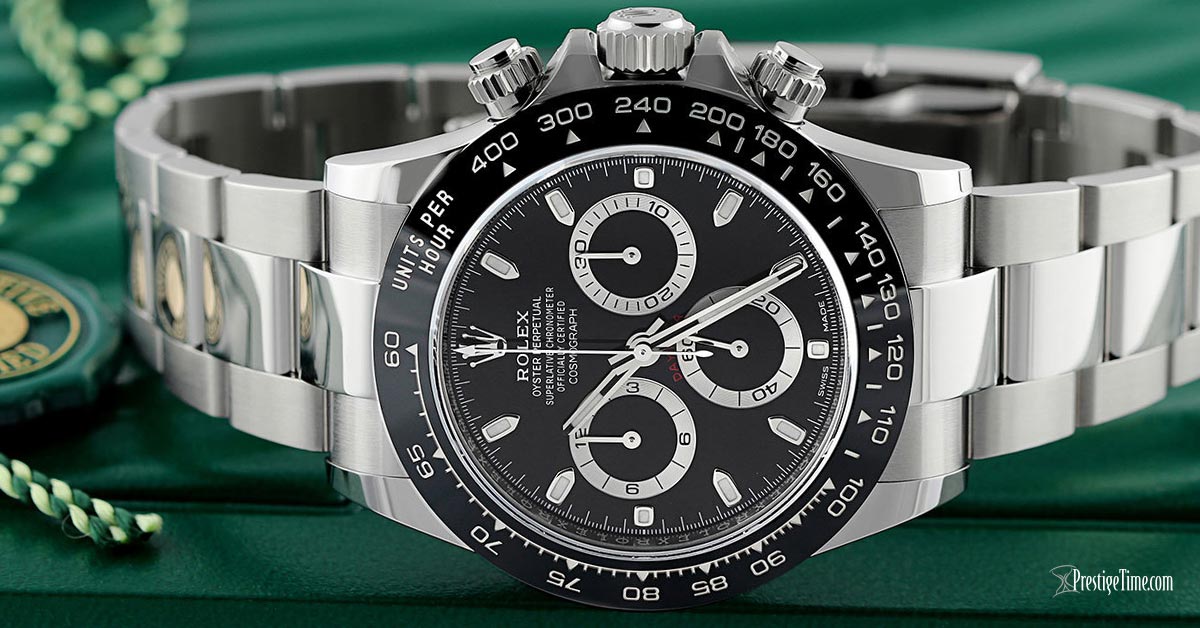
Rolex Cosmograph Daytona 116500LN Black Review
After the many years of popularity that the Rolex Daytona Chronograph enjoyed a few of the most popular models have been replaced with enhanced versions with only subtle aesthetic differences.
Today, we’ll be reviewing the Rolex Cosmograph Daytona reference number 116500LN Black which replaced model # 116520 Black which was the go-to stainless steel and black dial Rolex Daytona for many years.
Rolex Cosmograph Daytona 116500LN Black Review
Let's dissect this watch feature by feature in a detailed review that is easy to read and navigate.
BEZEL
The most noticeable difference between the two models is the addition of the black ceramic “Cerachrom” bezel. This new and improved fixed bezel is highly scratch-resistant, excellently resists corrosion and impervious to the color fading effects of UV rays. Compared to the polished stainless-steel bezel of its predecessor, the now black bezel gives the impression that it is a larger dial.
A few things about the bezel design also changed. Namely, the typeface which was used on the engraved tachymeter scale is bolder and more legible and is filled with a platinum PVD fill. Another slight difference on the bezel is the use of triangles instead of dots beneath the numerals on the tachymeter.
The numerals on the tachymeter now also rotate around the bezel and are no longer horizontally displayed the way they were on the previous model. A lot of thought has been put into the redesign of the bezel and it has been well received by Rolex Daytona fans everywhere.
CASE
The 40mm x 12.4mm thick oyster case is constructed of Rolex’s corrosion-resistant superalloy known as 904L steel which is known to hold its polish more than your standard stainless steel. While 904L steel is not necessarily the toughest steel alloy known to man, it does have more luster than others and is the perfect material for a Rolex. Other manufacturers are not equipped to use this more expensive type of steel and often have their cases produced for them. Since Rolex manufactures all its components in-house, they have an advantage.
As the world’s first waterproof case, the oyster case has almost become synonymous with the name Rolex. The patented “oyster” case has been one of Rolex’s notable signatures and has been around since its conception in 1926. A system that tightens and locks the monobloc middle case via a screw-down bezel, a screw-down case back, and a screw-down crown. Using this “Triplock” locking system the Daytona’s case is secured against water as a submarine hatch with a minimum water-resistance rating of 100m/300ft.
While you will see this “oyster” case used on practically all non-chronograph Rolex sports models, the Daytona has the addition of the screw-down sleeves protecting the pushers for the stopwatch function.
DIAL
The dial has not changed since the last model and why should it? There wasn’t anything that needed improving on the dial design since the Cosmograph Daytona chronograph is possibly the most recognizable chronograph dial out there.
From the applied polished steel hour markers with their luminous fill to the proportions, everything has stayed the same. The easy to read Chromalight display uses a long-lasting luminescent material that glows in the dark with a bright blue hue. Just like any Rolex Daytona chronograph, the word DAYTONA is printed in red and wraps around the top of the small running seconds located at the 6 o’clock position.
SUB-DIALS
Aesthetically, everything has stayed the same from the previous model when it comes to the silver-rimmed sub-registers on the dial. The bottom center sub-dial at the 6 o’clock position is the small running seconds sub-dial. The sub-registers on the right and left of this sub-dial at the 3 and 9 o’clock positions are used for the chronograph.
CHRONOGRAPH
The chronograph feature gives an extra function to the watch and is essentially a stopwatch allowing drivers to time their laps with up to an eighth of a second accuracy. The mechanical chronograph complication used in the Cosmograph Daytona was designed to have fewer parts than your standard chronograph making it a more dependable stopwatch. As a column-wheel chronograph with a vertical clutch mechanism which has a smoother start/stop and reset action than CAM actuated mechanisms.
The chronograph’s large central seconds hand sweeps across the dial very smoothly in that perpetual motion which a Rolex is famous for. The Sub-dial to the right of the dial at the 3 o’clock position is a 30-minute counter and across the dial at the 9 o’clock position is a 12-hour counter. These three hands are smoothly operated via the chronograph pushers which are the buttons located above and below the winding crown on the right side of the case.
MOVEMENT
Rolex uses their in-house caliber 4130 self-winding movements to power their Daytona watches which features their magnetic-resistant blue ‘Parachrom’ hairspring and stop-seconds for precise time setting.
The 4130 caliber is an automatic chronograph movement that will keep itself wound by using your kinetic energy to tighten the mainspring using a rotor. This will keep it wound provided you move your hands enough throughout the day.
If you don’t move all that much throughout the day, the winding crown can be used to tighten the spring manually. On a full wind, the power reserve should allow for the watch to run for approximately 72 hours or 66 hours if you are running the chronograph function.
The Caliber 4130 is also a COSC certified movement which means it has a prestigious Chronometer designation testifying to its reliability and high precision with a maximum of -4/+6 seconds per day in deviation.
Once the Swiss Official Chronometer Testing Institute issues the caliber a COSC certificate, the caliber is essentially awarded a chronometer designation and is then sent back to Rolex for further testing.
Rolex then installs the COSC certified chronometer movement into the watch case and conducts further testing until the caliber receives a new in-house designation called the Superlative Chronometer. This is issued by Rolex once the caliber has achieved an accuracy of -2/+2 seconds per day which is at least twice as accurate as a COSC chronometer!
BRACELET
Rolex’s Oyster bracelet is made of three-piece oystersteel links. The two outer links have a brushed finish while the center link has a beautiful polished finish. The links at either end of the bracelet are connected to the polished lugs on the case so that when you look at it, the finishing alternates from polished to brushed and then again to the polished finish for the center link.
CLASP
The oysterlock double-locking folding clasp is fitted with Rolex’s patented Easylink5mm extension link which allows you to make a quick 5mm micro-adjustment to the size of the bracelet. This is a very handy feature that doesn’t require any special tools to adjust. This feature was designed to allow your watch to compensate in size for the natural expansion and contraction of the wrist when there are fluctuations in temperature and humidity.
SUMMARY
The demand for this watch was through the roof from day one. In fact, before Rolex even released the new steel Daytona watches to their distribution network, preorders poured in and all of them were already presold before they even hit stores. There was a backlog of people waiting to get their hands on one (or is it to get one on their hands?). Point being this is not always a very easy watch to find and lately, they will sell for well above the manufacturer’s suggested retail price based on supply and demand alone.
Like all Rolex sport models, this is built tough. It has excellent accuracy and enough water resistance that (provided that it’s not in hot water) you wouldn’t have to worry if it got wet while swimming, snorkeling or showering. The Rolex brand is the most recognized watch brand in the world so you would certainly get lots of compliments and attention with one of these on your wrist.
Rolex also has one of the best warranties in the business. Their 5-year warranty allows you to sleep at night knowing that you’ll have the Daytona for years to come.







